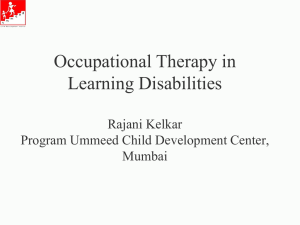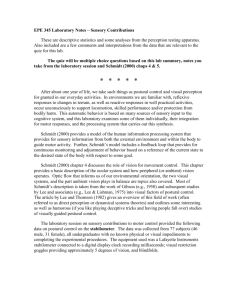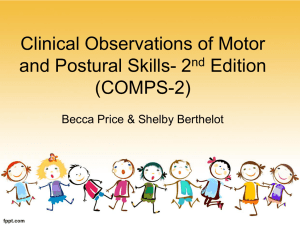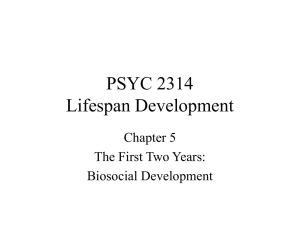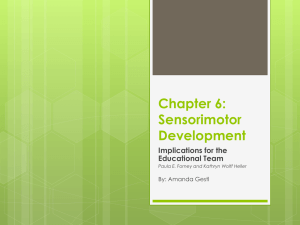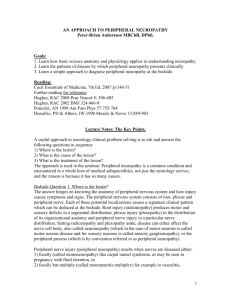Overview of Balance System
advertisement
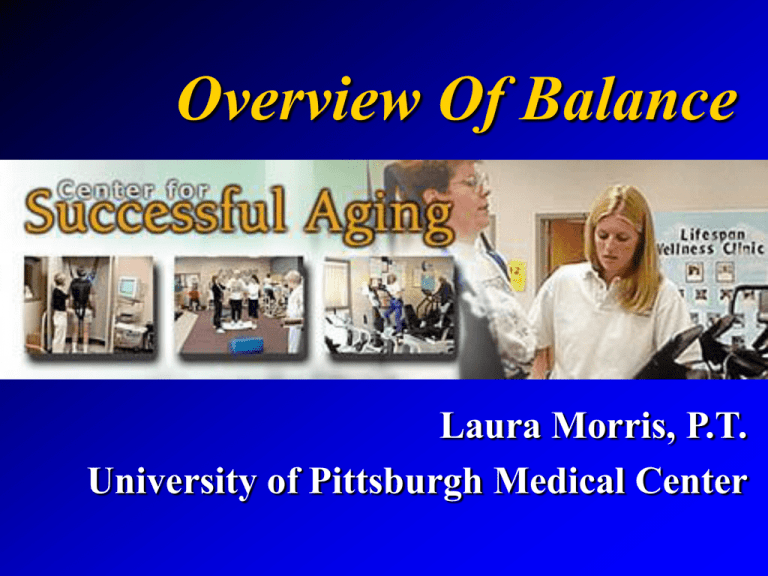
Overview Of Balance Laura Morris, P.T. University of Pittsburgh Medical Center SESSION OBJECTIVES Describe the important terminology used in the study of balance and mobility Identify the multiple systems that contribute to postural stability Describe the major age-related changes in balance and mobility Subcomponents of Postural Stability Flexibility Tone Joint Range Temporal Pattern Morphology Spatial Biomechanics Strength Detection of Instability Motor Coordination Multiple Tasking Sensory Organization Motion Perception Verticality Adaptation Predictive Central Set Sensory Strategies Limits of Stability Horak, 1997 Systems Contributing to Control of Balance Sensory peripheral and central Motor including musculoskeletal Cognitive/Attention Important Terminology Balance • A process by which we control the body’s Center of Mass (COM) with respect to the base of support (BOS), whether it is stationary or moving. (standing quietly, leaning in space, walking) Mobility • The ability to independently and safely move oneself from one place to another. (transfers, climbing stairs, walking, running) Important Terminology Anticipatory Postural Control • Actions that can be planned in advance (negotiating obstacles, moving over uneven terrain in good lighting) Reactive Postural Control • Actions cannot be planned in advance. Occur in response to a set of environmental conditions (stepping in a hole, being unexpectedly bumped) Important Terminology Stability Limits • The maximum distance leaned in any direction without changing the BOS • Boundaries will vary based on individual’s abilities, task being performed, and environmental constraints. Postural Control Strategies Ankle • Used to control sway when standing quietly or swaying over small distance in forward-backward direction • Requires adequate Range Of Motion (ROM) and strength in muscles surrounding ankle joint. • Sufficient level of sensation in feet and ankles also important. Postural Control Strategies Hip • Used when surface below feet is narrow or compliant or, when swaying closer to stability limits. • Requires adequate level of strength and ROM in hip region. Postural Control Strategies Step • Used when the boundaries of stability are exceeded • Requires sufficient level of lower body strength and power, adequate ROM in hip. • Adequate level of function in sensory and motor systems Age-Related Changes in the Older Adult Commonly Observed Impairments Peripheral Sensory Central Sensory Central Motor Peripheral Motor Peripheral Sensory Impairments Reduced Vision • Acuity • Contrast sensitivity • Depth perception Effect on Motor Behavior? • Ability to accurately perceive and/or anticipate changes in surface and obstacles • Navigation in low or changing light Common Eye Diseases Courtesy of the National Eye Institute, National Institute of Health Peripheral Sensory Impairments Reduced and/or slowed sensation in touch receptors • Increase in vibration threshold • Decreased proprioception Effect on Motor Behavior? • Ability to feel quality of contact with support surface • Static and changing position of limbs in space. Peripheral Sensory Impairments Reduced Vestibular Function • Loss of hair cells • Reduction in Vestibulo-ocular reflex (VOR) Effect on Motor Behavior? • Head position and/or movement of head in space • Resolution of sensory conflict • Balance when vision and somatosensation absent or distorted. Central Sensory Impairments Visually dependent Poor integration of sensory inputs Distorted perception of true vertical and/or horizontal Slowed processing of sensory feedback Central Motor Impairments Increased planning time Increased movement times Strategy selection problems Increased variation in temporal sequencing of muscles Loss of anticipatory control Effect on Motor Behavior? Slower to initiate and execute movements, particularly in complex sensory environments Inappropriate choice of movement strategies Slowed gait speed, hesitation during obstacle negotiation. Overall quality of motor coordination Peripheral Motor Impairments Decreased joint range of motion Decreased strength and power in lower body muscle groups Decreased strength in upper body muscle groups Decreased muscular endurance Effect on Motor Behavior? Performance of basic, intermediate, and advanced activities of daily living (ADLs). Slowed and/or ineffective responses to sudden loss of balance Quality of motor performance Increased fatigue Cognitive Impairment Reduction in Working Memory Reduced attentional abilities Multiple Tasks Certain sensory environments Reduction in fluid intelligence Cognitive Impairment Fluid Intelligence: • Thinking “on the fly” (problem solving) Crystallized Intelligence: • What you know (vocabulary) Seated Moving Single Task Demands Multiple Surface Type Cognition Strength Environment Lighting Standing Visual Flow Individual Capabilities ROM Sensory Loss Individual Capabilities: Nellie Strength/Motor control mildly impaired in both lower extremities Sensation is within normal limits (WNL) for her age but vision is impaired Safety judgment and cognition poor- Not capable of running down stairs, but routinely attempts it anyway Task Demands Research Evidence: • Attentional demands for postural stability increase in older adults • Inability to divide attention between tasks and postural stability is a contributing factor to falls (e.g., carrying groceries while chatting with friend) Task Demands: Judy Unable to climb or descend stairs without effort and fear Experiences difficulty talking with her husband as she does the dishes No longer works in the garden Environmental Constraints To limit or not to limit, that is the question… Decreased environmental hazards Less engaging in activities in community short term reduced exposure less falls HOWEVER, long term reduced exposure deconditioning, less self confidence MORE FALLS! Environmental Constraints: Billie Widowed one year ago Gave dog away as she didn’t feel safe walking her Had to give up volunteer positions when husband fell ill, has not returned Doesn’t feel safe walking outside anymore, won’t go out at night Can Age-Related Changes be reversed? YES, if: Intervention targets source(s) of balance-related problems Repeatedly exposes older adults to changing task demands and environmental constraints
